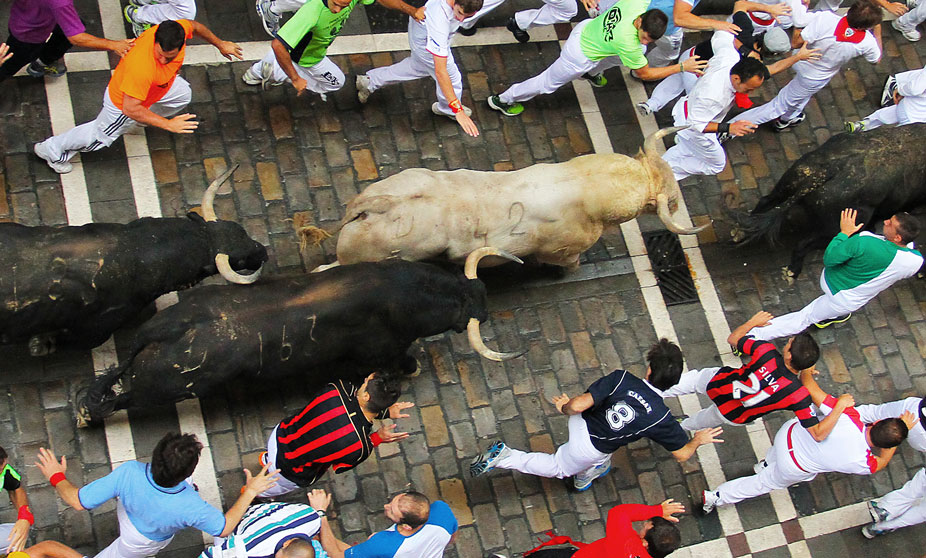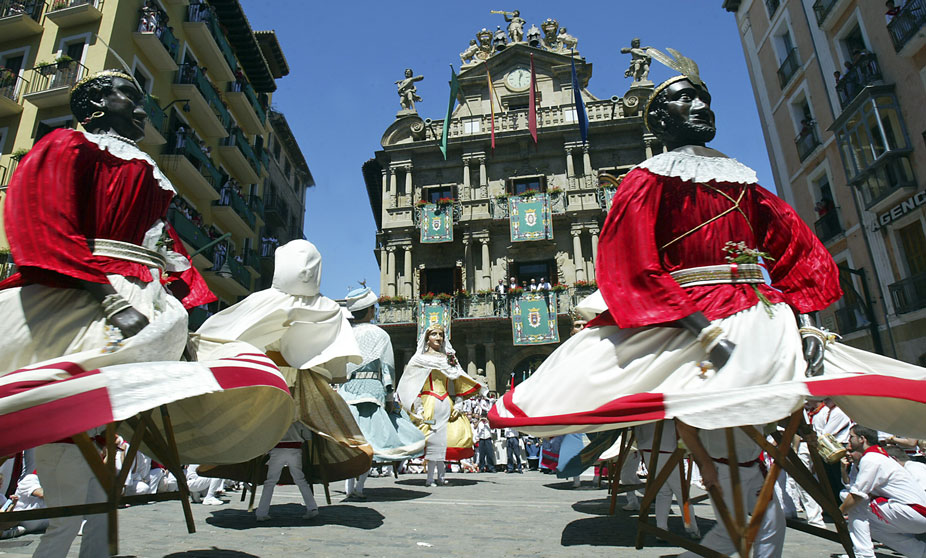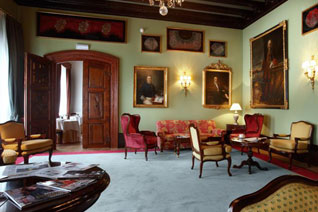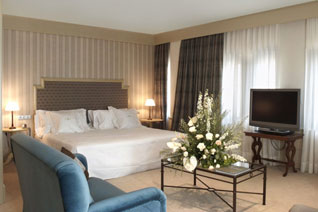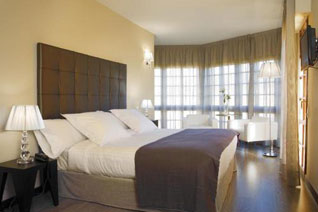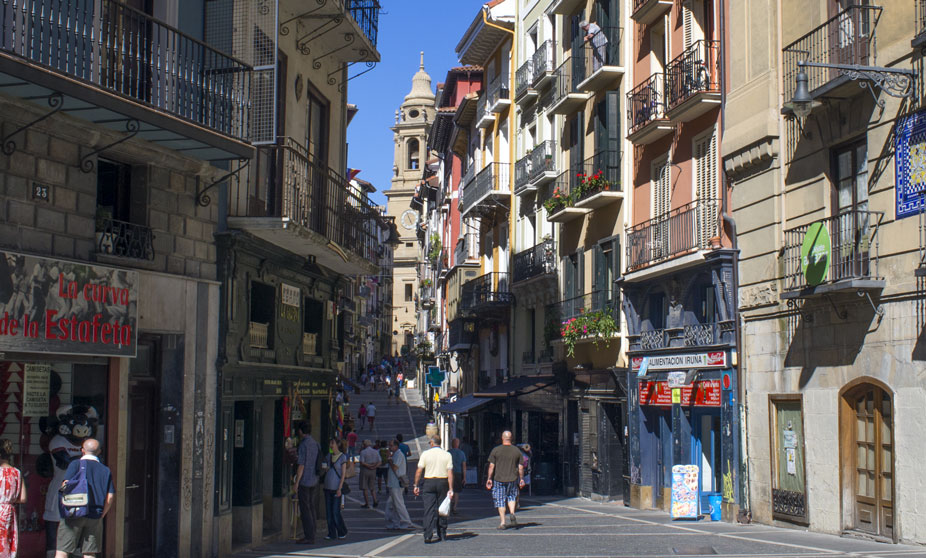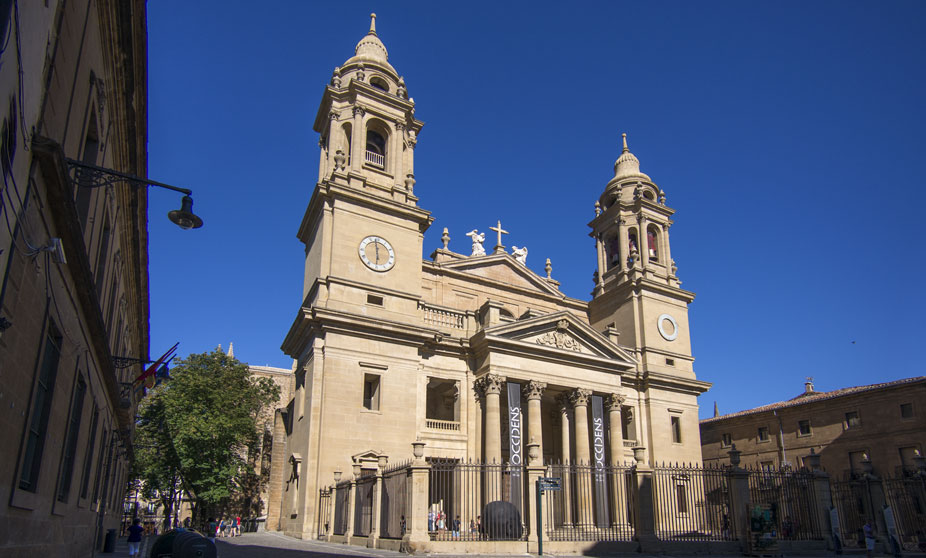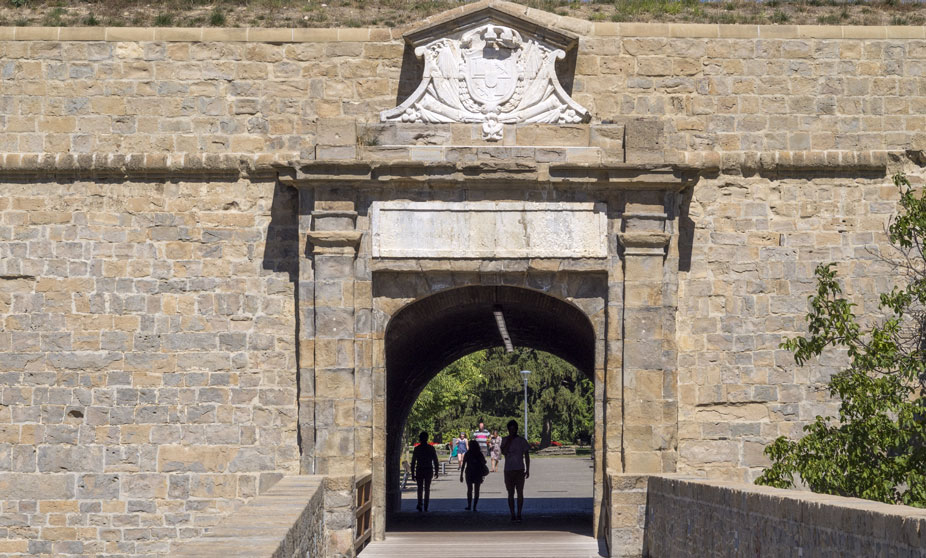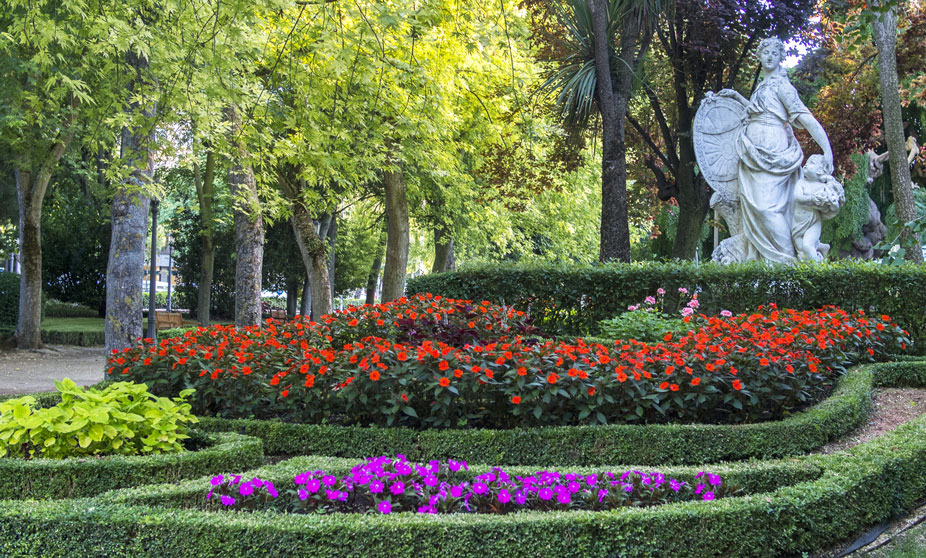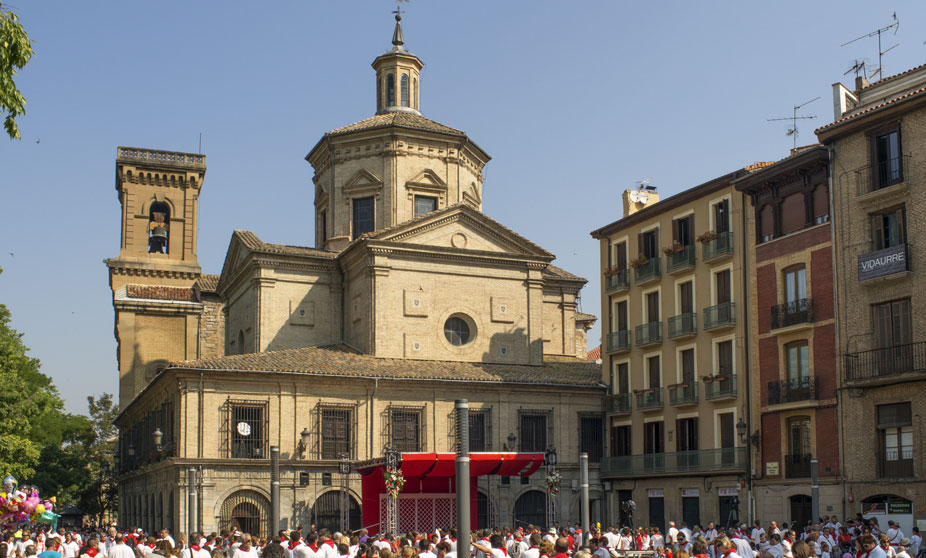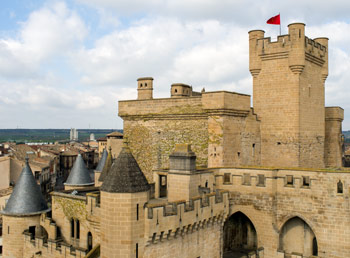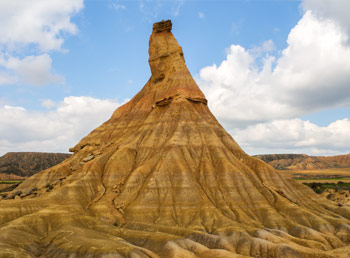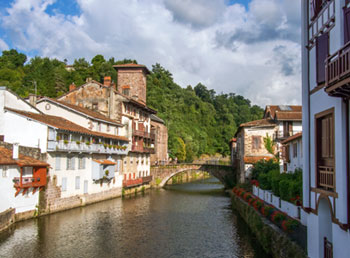We have put together a hand selected list of the most important things to do and see in Pamplona. Everything from the Old Town to visiting the Santa Maria Cathedral – if it deals with Pamplona tourism, we’ve got you covered.
1
![Pamplona's Old Town Pamplona Tourism]()
Pamplona's Old Town
![Art nouveau pharmacy in the old town Things to Do in Pamplona]()
Art nouveau pharmacy in the old town
Pamplona is proud to have a beautiful Old Town, which is definitely the nicest part of the city and also where visitors spend most of their time. The Old Town was once surrounded by a defensive wall and some sections of it can still be seen today.
The stone-paved streets of the Old Town are mainly for pedestrians and wind their way through the historical heart of the city, between medieval churches, palaces and, of course, plenty of bars and restaurants.
The  Castle Square (Plaza del Castillo) is the center of life in the Old Town and is lined with restaurants, cafes and hotels. Here, Ernest Hemingway would sit and drink coffee while working on his book, “The Sun Also Rises.”
Castle Square (Plaza del Castillo) is the center of life in the Old Town and is lined with restaurants, cafes and hotels. Here, Ernest Hemingway would sit and drink coffee while working on his book, “The Sun Also Rises.”
But if there is a famous street within the Old Town, it is the  Estafeta street. The street is best known for being the main path the bulls run down for the “Running of the Bulls” that takes place during San Fermin.
Estafeta street. The street is best known for being the main path the bulls run down for the “Running of the Bulls” that takes place during San Fermin.
Other highlights of Pamplona’s Old Town are the  cathedral, the
cathedral, the  city hall and the
city hall and the  Navarre Museum. Apart from the cathedral, there are three more important churches in the Old Town: Saint Nicolas Church, Saint Saturnino Church and Saint Lawrence Church.
Navarre Museum. Apart from the cathedral, there are three more important churches in the Old Town: Saint Nicolas Church, Saint Saturnino Church and Saint Lawrence Church.
2
![Plaza del Castillo - Pamplona Plaza del Castillo - Pamplona, Spain]()
Plaza del Castillo
The Castle Square (Plaza del Castillo) is Pamplona’s main square and is frequented by both locals and tourists alike. It is a place full of bars and restaurants with terraces. The Plaza del Castillo is just the perfect place to start or end a walk through the  Old Town.
Old Town.
Throughout the centuries, the Castle Square has been witness of all types of events such as markets, concerts, celebrations, etc. For example, from the end of the 14th century until 1844, it was used as the bullring of the city.
When Ernest Hemingway was in Pamplona, he of course spent a lot time in the Plaza del Castillo. Some of his favorites at the square were the bar Txoko, the Hotel La Perla and the Café Iruña. A statue of Hemingway can be found at the Café Iruña.
4
![Interior of the Santa Maria Cathedral - Pamplona Interior of the Santa Maria Cathedral - Pamplona, Spain]()
Interior of the Santa Maria Cathedral
![Cathedral of Santa Maria la Real - Pamplona Cathedral of Santa Maria la Real - Pamplona, Spain]()
Cathedral of Santa Maria la Real
![Cathedral Museum - Pamplona Cathedral Museum - Pamplona, Spain]()
Cathedral Museum
Located in Pamplona’s Old Town, the Santa Maria Cathedral is probably the most important monument of the city and is definitely the one that contains the largest amount of artistic and historical treasures.
The cathedral is actually part of the Cathedral Museum. Inside, not only do visitors have access to the more common sections of any cathedral such as church, cloister and sacristy, but also to the cillería, refectory, chapter house, kitchen and bedrooms.
While the spaces that can be seen today in the museum were built in different periods of time, the majority of them were erected during the 14th and 15th centuries in the same place where originally a Roman temple and the Roman city of Pompaelo were located.
The building’s neoclassical western façade was completed more recently in the 18th century. It is contrasted by the interior which was built in gothic style.
In front of the cathedral’s presbytery, stands the mausoleum of King Charles III and his wife. King Charles III is very important in Pamplona’s history because he was responsible for the city’s unification in 1423.
Underneath the mausoleum, there is a crypt with the remains of all the kings of the Kingdom of Navarre since 1134. Unfortunately, this crypt is not open to the public.
The cloister was built in gothic style between 1286 and 1472 and is considered to be the best preserved cloister of the 14th century. Another very interesting room in the museum is the kitchen which was completely built of stone and has one huge chimney in each corner of the room. It is one of the only three existing gothic kitchens in Europe.
Even if you are not into churches, if you are going to visit a museum in Pamplona, this should be the one.
OPENING TIMES – CATHEDRAL MUSEUM
Monday to Saturday: 10:30 am to 5 pm
*Open until 7pm from April to October
ADMISSION – CATHEDRAL MUSEUM
Adults: 5 €
Senior citizens: 4 €
Pilgrims: 3 €
Children (7-13): 3 €
5
![Pamplona's City Hall Pamplona's City Hall - Spain]()
Pamplona's City Hall
King Charles III ordered the construction of the city hall in 1423. It was built in the center of the town where the three neighborhoods of the three ethnic groups met so that it could act as a symbol of peace. Since then, the seat of municipal government has been located at that same place.
By the middle of the 18th century, the city hall building was a mere ruin and, in 1752, it was completely demolished to be rebuilt from scratch. The new construction became one of the most outstanding examples of baroque civil architecture in the city.
However, in 1951, the building was torn down again, but this time the façade was preserved. While the lower part of the façade that we see today and all other decoration have a baroque style, the figures that adorn the top of the building are neoclassical.
PRACTICAL INFORMATION
Guided visits to the City Hall are offered for groups of at least 12 people. It is necessary to book at least one month in advance here.
Admission: free
Language: Spanish
Duration: 30 minutes
6
![Interior of the Navarre Museum - Pamplona Interior of the Navarre Museum - Pamplona, Spain]()
Interior of the Navarre Museum
![Navarre Museum - Pamplona Navarre Museum - Pamplona, Spain]()
Navarre Museum
![Specimen at the Navarre Museum - Pamplona Specimen at the Navarre Museum - Pamplona, Spain]()
Specimen at the Navarre Museum
The Navarre Museum is a public museum from the Government of Navarre that houses an archeological and artistic collection related to Navarre and its history. It is one of the main museums of the city.
Although it originally opened its doors in 1910, the Navarre Museum has been housed in the current location in Pamplona’s Old Town since 1956.
The building where the museum is located dates back to the 16th century and it first functioned as a hospital (the hospital of Nuestra Señora de la Misericordia). Currently, however, only the façade and chapel are original.
The collection of the Navarre Museum is comprised of pieces from prehistoric times and continues until the 20th century. Apart from some Roman artifacts and mosaics, the other highlight of the collection is an impressive portrait of the Marquis of San Adrián made by Francisco Goya.
The Navarre Museum is a very interesting museum in a very interesting location that sadly seems to be undervalued. If you have the time, we recommend to check it out.
OPENING TIMES
Tuesday to Saturday: 9:30 am to 2 pm & 5 pm to 7 pm
Sundays & holidays: 11 am to 2 pm
Mondays: closed
ADMISSION
Adults: 2 €
Students: 1 €
Seniors, under 18 years, unemployed, pilgrims: free
* Free for everyone on Saturday afternoon and Sundays
7
![Medieval City Wall - Pamplona Medieval City Wall - Pamplona, Spain]()
Medieval City Wall
In its early days, Pamplona was a fortified town encompassed by a wall. Although much of that wall was demolished when the city expanded in 1915, some of its sections still remain today.
For those interested in learning more about Pamplona and its wall, it is possible to visit the Center of Interpretation of the Fortifications. It is located in the "Fortín de San Bartolomé,” where the streets Arrieta and Aralar meet, next to the bullring.
Another way to discover and enjoy Pamplona’s wall is to walk along it. The longest and probably most beautiful walk by the wall is the one that goes from the Center of Interpretation to the New Gate (Portal Nuevo) passing next to the  Santa Maria Cathedral and the
Santa Maria Cathedral and the  Navarre Museum.
Navarre Museum.
Center of Interpretation of the Fortifications
OPENING TIMES
March 16 to October 28:
- Tuesday to Saturday: 11am-2pm & 4pm-7pm
- Sundays: 11am-2pm
October 29 to March 15:
- Tuesday to Saturday: 11am-2pm & 3pm-6pm
- Sundays: 11am-2pm
8
![Citadel & Vuelta del Castillo Park - Pamplona Citadel & Vuelta del Castillo Park - Pamplona, Spain]()
Citadel & Vuelta del Castillo Park
The citadel and the Vuelta del Castillo Park that surround it, form the biggest and most important green area of Pamplona.
The citadel was built by order of Philip II of Spain in 1571 as part of the general strengthening of the city’s fortifications. It was designed in pentagonal shape to be able to combat every angle of attack. The citadel is now considered the best example of military architecture in Spanish renaissance style.
The citadel was used by the military until 1964, and afterwards was turned into a park. Today, the citadel as well as the green area that surrounds it, is frequented by locals of all ages.
Apart from people walking and practicing sports, the buildings that were left from the military are now used as art and cultural exhibition centers. Among those buildings are the Magazine (Polvorín) which is the oldest building of the complex, the Oven (horno) where bread was baked and the Weapons Building (Sala de Armas) which was originally the artillery warehouse.
There are also several sculptures spread throughout the park from artists such as Jorge Oteiza and Faustino Aizkorbe.
OPENING TIMES – MAIN GATE
Monday to Friday: 7:30 am to 9:30 pm
Saturdays: 8 am to 9:30 pm
Sundays & holidays: 9 am to 9:30 pm
Closed: 4th - 16th of July, 25th December, 1st & 6th January
OPENING TIMES – EXHIBITION ROOMS
November to April
Tuesday to Friday: 6 pm to 8:30 pm
Saturdays: 12 pm to 2 pm & 6 pm to 8:30 pm
Sundays & holidays: 12 pm to 2 pm
May to October
Tuesday to Friday: 6:30 pm to 9 pm
Saturdays: 12 pm to 2 pm & 6:30 pm to 9 pm
Sundays & holidays: 12 pm to 2 pm
9
![Taconera Park - Pamplona Taconera Park - Pamplona, Spain]()
Taconera Park
Dating back to 1830, the Taconera Park is the oldest and finest park of Pamplona. Its gardens are nicely taken care of and feature colorful floral arrangements.
The perfect entry point to the Taconera Park is the Saint Nicolas Gate, which is a beautiful baroque recreation of a triumphal arch. Originally, it was one of the six entry gates into the walled city. Some parts of that original wall can also be found within the park.
There is also a small zoological park in the lower part of Taconera Park, next to the moats. The zoological area is home to deer, ducks, rabbits, etc.
10
![Saint Lawrence Church - Pamplona Saint Lawrence Church - Pamplona, Spain]()
Saint Lawrence Church
The Saint Lawrence Church is located in the western corner of the Old Town, right next to the  Taconera Park. It was originally built in the 14th century as a church-fortress, since it was part of the defensive system of the city. However, what we see today is actually a building that was erected during the 17th and 18th centuries in neoclassical style.
Taconera Park. It was originally built in the 14th century as a church-fortress, since it was part of the defensive system of the city. However, what we see today is actually a building that was erected during the 17th and 18th centuries in neoclassical style.
The main highlight of the church is the Saint Fermin chapel, a neoclassical style chapel where the Saint Fermin figure is located. The figure dates back to the 15th century and is made of wood and silver. Saint Fermin is also locally known as the “morenico” (the “little tanned one”) because his face has a dark complexion.
The figure of Saint Fermin is kept at the Saint Lawrence Church for the entire year and only leaves the building the 7th of July, the day of the Saint Fermin festivity, when it is taken in procession through the streets of Pamplona’s Old Town.
MASS TIMES
Monday to Friday: 8:30 am, 11 am & 7:30 pm
Saturdays & days before a holiday: 6 pm
Sundays & holidays: 9 am, 11 am, 12 pm, 1 pm, 6 pm & 7 pm
OPENING TIMES
Monday to Saturday: 8 am to 12 pm & 5:30 pm to 8 pm
Sundays & holidays: 8:30 am to 1:45 pm & 5:30 pm to 8 pm

